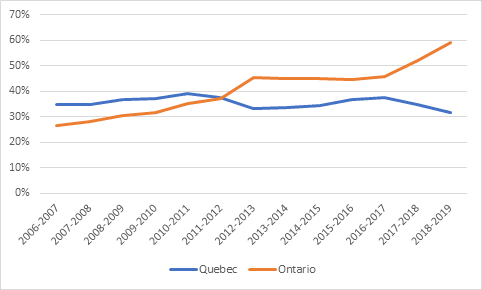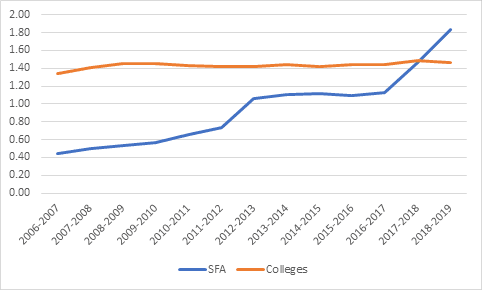Our usual annual round-up of provincial budgets will come Wednesday, right after Saskatchewan posts its numbers, but as I was writing a draft of the piece I realized it makes almost no sense to talk about national trends in provincial funding without looking at what is going on in Ontario, because to a large extent it drives the national numbers. And what is going on in Ontario – what has been going on in Ontario – over the past decade is so far out of whack with the rest of the system that it skews the overall picture. So, today Ontario, Wednesday the rest of the country.
The most important thing to understand about the Ontario Liberals is that they have taken the position that any new money should go towards students, and none of it should go to institutions. To offset this, a bit, they allow institutions to raise fees a little bit for domestic students (theoretically 3%, but in practice somewhat more due to shifts in enrolment) and charge whatever the hell they want to however many international students they can find. You won’t find this in a policy statement anywhere, of course, but it is 100% the policy in practice.
For instance, let us take a quick look at changes in budgeted spending on student assistance vs. institutions over the past decade (I’m using budgets, not actuals, because I don’t have to wait two years to get the latest numbers and yes that does affect accuracy a bit but overall trends show up just fine). Check out figure 1:
Figure 1: Provincial government spending, SFA vs. institutions, Ontario, 2006-07 to 2018-19 (2006=100)
Basically, student aid funding and SFA funding were going both growing by about 25-30% in real terms during the period 2006-07 to 2009-10 (which was massive, by the way, though I don’t remember the PSE community thanking their lucky stars at the time). Then everything changes. Government funding flatlines before starting to fall a couple of years ago (mainly due to drops in capital spending). Total government spending on post-secondary institutions is now about 10% lower in real terms than it was in 2011-12. Spending on student aid, on the other hand, has more than tripled since 2009-2010 (and quadrupled if you start the count at 2006-07).
Now part of that has to do with the 2016 decision to get rid of provincial tax credits in order to fund the new targeted free tuition program, a measure which, if I recall correctly, probably accounts for $500 million of the $700 million increase we’ve seen in the last two years. But, of course, what that means is a) total new resources going to student aid (i.e. net of the tax credit reinvestment) since 2006-07 is equal to about $800 million and b) the targeted free tuition program, which was supposed to be paid for entirely through a re-investment of existing grants and tax credits, is probably costing about $200 million more than expected.
To get a sense of the scale of the Ontario investment, let’s take a look at figure 2, which plots the evolution of Ontario’s and Quebec’s spending on student assistance as a percentage of total provincial spending on students’ aid. Back in 2006-2007, Ontario only made up 25% of total provincial spending on student aid (at the time amounting to $1.7 billion in today’s dollars). In 2018-2019, Ontario will spend $1.8 billion on student aid – more than all provinces combined from as recently as 2009-2010—meaning it will account for about 60% of total provincial spending today. Quebec, meanwhile, will fall from 35% of total provincial spending to 30%, despite substantial increases in real spending.
Figure 2: Ontario and Quebec spending on SFA as a percentage of total (national) provincial government expenditures on SFA, 2006-2007 to 2018-2019
Another way to look at Ontario’s spending is to track changes in what the province is spending on student aid compared to what it spends on community colleges. And this leads to this doozy of a chart:
Figure 3: Provincial Government Spending on SFA and community college operating grants, in billions of 2018 dollars, Ontario, 2006-2007 to 2018-2019
All of this would be pretty unobjectionable if there was any evidence at all that access to post-secondary education was a significant barrier to education in Ontario. But there isn’t. In fact, Statistics Canada has repeatedly found the opposite, that access for low-income youth is better in Ontario than anywhere else in the country, and was so long before any of these changes were enacted. You can make a re-distributive case for the shift from tax credits to targeted grants – but the case for more spending on student support as a whole actually doesn’t look so hot.
In fact, colleges are the institutions that do the hard work in expanding access. They provide options and services to those who otherwise would do without. A government that actually cared about access would not be flatlining institutions – especially colleges – while ramping up student aid spending. This balance is simply wrong. It is now well beyond the point where one can make the case that access dollars are being spent efficiently. Finances are not the only barrier to education: giving students money to go to institutions that can no longer afford to provide decent classes or student services (or at least not without vastly expanding their international enrolment) risks setting people up for failure.
Remember, I’m one of the biggest fans of the government’s targeted free tuition program. But this feed-the-student/starve-the-institution approach has to stop. Enough is enough: no more increases to the student aid budget. Fund the institutions instead.




 Tweet this post
Tweet this post

“Quebec, meanwhile, will fall from 35% of total provincial spending to 30%, despite substantial increases in real spending.”
Small point. It may be, although the figures are not presented in your piece, that the fall in Quebec is more accurately described as “because of” rather than “despite” the increases in real (overall?) spending.
Enough